Auto cropping Authentik user avatars
Published on Feb 23, 2025 by Kalitsune.
Introduction
Authentik doesn’t provide an easy way to implement avatars for users by default. However it is very much doable thanks to the power of policies and attributes!
despite being new to authentik and its inner workings, I was able to easily find a tutorial that did more or less what I wanted: https://github.com/goauthentik/authentik/discussions/6824
But it was missing something! You couldn’t safely upload SVGs (and god knows I love SVGs), and if the picture you used wasn’t square this could generate errors down the line with other services like Nextcloud.
In short: while the solution proposed was good, it was still unpolished.
That’s why I took the liberty to improve it!
Fixing the problem: imgproxy
Something tricky about the authentik setup is that it runs inside of a docker container so you’ll have an hard time running additional software if it’s not present on the docker image itself.
I tried using ffmpeg or image-magick using their appimage but those don’t work on docker and I wasn’t able to run them in any safe way. And it’s not like I could install pillow either…
But if I couldn’t run those inside of the docker container, I could use another container to expose an API that would allow me to manipulate the image from my little python script!
That’s when I found imgproxy. A supper tiny, power-packed image processing webserver written in go. This project was a perfect fit for my needs! Time to implement it.
Adding imgproxy to the compose file
By that point I had already tweaked my original docker compose file quite a bit, notably by adding configs for traefik, my reverse proxy, so there might be extra stuff you might want to remove.
but here’s the config I used:
services:
postgresql:
image: docker.io/library/postgres:16-alpine
restart: unless-stopped
healthcheck:
test:
- CMD-SHELL
- pg_isready -d $${POSTGRES_DB} -U $${POSTGRES_USER}
start_period: 20s
interval: 30s
retries: 5
timeout: 5s
volumes:
- database:/var/lib/postgresql/data
environment:
POSTGRES_PASSWORD: ${PG_PASS:?database password required}
POSTGRES_USER: ${PG_USER:-authentik}
POSTGRES_DB: ${PG_DB:-authentik}
env_file:
- .env
networks:
- default
redis:
image: docker.io/library/redis:alpine
command: --save 60 1 --loglevel warning
restart: unless-stopped
healthcheck:
test:
- CMD-SHELL
- redis-cli ping | grep PONG
start_period: 20s
interval: 30s
retries: 5
timeout: 3s
volumes:
- redis:/data
networks:
- default
authentik:
image: ${AUTHENTIK_IMAGE:-ghcr.io/goauthentik/server}:${AUTHENTIK_TAG:-2024.12.3}
restart: unless-stopped
command: server
container_name: authentik
labels:
traefik.enable: true
traefik.http.routers.authentik.rule: Host(`auth.example.com`)
traefik.http.routers.authentik.tls.certresolver: letsencryptresolver
traefik.http.routers.authentik.entrypoints: websecure
traefik.http.routers.authentik.service: authentik-svc
traefik.http.services.authentik-svc.loadBalancer.server.port: 9000
environment:
AUTHENTIK_REDIS__HOST: redis
AUTHENTIK_POSTGRESQL__HOST: postgresql
AUTHENTIK_POSTGRESQL__USER: ${PG_USER:-authentik}
AUTHENTIK_POSTGRESQL__NAME: ${PG_DB:-authentik}
AUTHENTIK_POSTGRESQL__PASSWORD: ${PG_PASS}
volumes:
- media:/media
- templates:/templates
env_file:
- .env
ports:
- ${COMPOSE_PORT_HTTP:-9000}:9000
- ${COMPOSE_PORT_HTTPS:-9443}:9443
networks:
- default
- auth
- nextcloud-aio
- proxy
depends_on:
imgproxy:
condition: service_started
postgresql:
condition: service_healthy
redis:
condition: service_healthy
worker:
image: ${AUTHENTIK_IMAGE:-ghcr.io/goauthentik/server}:${AUTHENTIK_TAG:-2024.12.3}
restart: unless-stopped
command: worker
environment:
AUTHENTIK_REDIS__HOST: redis
AUTHENTIK_POSTGRESQL__HOST: postgresql
AUTHENTIK_POSTGRESQL__USER: ${PG_USER:-authentik}
AUTHENTIK_POSTGRESQL__NAME: ${PG_DB:-authentik}
AUTHENTIK_POSTGRESQL__PASSWORD: ${PG_PASS}
# `user: root` and the docker socket volume are optional.
# See more for the docker socket integration here:
# https://goauthentik.io/docs/outposts/integrations/docker
# Removing `user: root` also prevents the worker from fixing the permissions
# on the mounted folders, so when removing this make sure the folders have the correct UID/GID
# (1000:1000 by default)
user: root
volumes:
- /var/run/docker.sock:/var/run/docker.sock
- media:/media
- certs:/certs
- templates:/templates
env_file:
- .env
depends_on:
postgresql:
condition: service_healthy
redis:
condition: service_healthy
networks:
- default
imgproxy:
image: ghcr.io/imgproxy/imgproxy:latest
networks:
- default
volumes:
database: null
redis: null
templates: null
certs: null
media: null
networks:
default: null
auth: null
proxy:
external: trueNetwork-wise, my configs uses 3 different networks:
default: the default network for my authentik stack, it is only intended to be used by the services in this compose file.auth: a network binding the authentik server with the services that need to interact with it directly, mainly for LDAP.proxy: this is the network used by my reverse proxy traefik.
You’re free to replicate my setup as you’d like, however only the default network is important here.
Configuring the policy
Now that we’ve added an imgproxy instance to our authentik stack, we can create the policy that will be using it:
Go to Customization> Policies and create a new policy, select Expression Policy.
Call it whatever you’d like, I called mine foxid-settings-avatar.
And paste the following python script:
AK_DOMAIN = "auth.kalitsune.net"
FILE_PATH = "/media/user-avatars/"
URL_PATH = f"https://{AK_DOMAIN}{FILE_PATH}"
IMGPROXY_URL = "http://imgproxy:8080" # URL where imgproxy is accessible
AK_LOCAL_URL = "http://authentik:9000" # Local url where imgproxy can access authentik. If none just put the same as AK_DOMAIN
TARGET_SIZE = 1024 # Desired square dimension for the avatar
ACCEPTED_FILE_TYPES = {
"image/png": "png",
"image/jpeg": "jpeg",
"image/webp": "webp",
"image/svg+xml": "svg", # imgproxy sanitizes svgs by default so this is fine (as long as you have this option enabled on your instance)
"image/gif": "gif",
"image/bmp": "bmp",
"image/vnd.microsoft.icon": "ico"
}
EMPTY_FILE = "data:application/octet-stream;base64,"
from humanize import naturalsize
from uuid import uuid4
from base64 import b64decode
from os import remove
from os.path import isfile, join
import urllib.request
import urllib.parse
import base64
def remove_old_avatar_file():
if not hasattr(request.user, "avatar"):
return
avatar = request.user.attributes.get("avatar", None)
if avatar:
components = avatar.split(URL_PATH, 1)
if len(components) == 2 and components[0] == "" and components[1]:
old_filename = FILE_PATH + components[1]
if isfile(old_filename):
remove(old_filename)
prompt_data = request.context.get("prompt_data")
avatar_overwritten = False
if "avatar" in prompt_data.get("attributes", {}):
avatar = prompt_data["attributes"]["avatar"]
if avatar == EMPTY_FILE:
# No upload file specified, ignore
del prompt_data["attributes"]["avatar"]
else:
avatar_mimetype = avatar.split("data:", 1)[1].split(";", 1)[0]
if avatar_mimetype not in ACCEPTED_FILE_TYPES:
ak_message("User avatar must be an image (" + ", ".join(ACCEPTED_FILE_TYPES.values()) + ") file.")
return False
# Decode the base64 data from the upload
avatar_base64 = avatar.split(",", 1)[1]
avatar_binary = b64decode(avatar_base64)
# Write the original image to a temporary file in FILE_PATH.
# This file must be accessible via the public URL (URL_PATH) for imgproxy.
temp_filename = str(uuid4()) + "." + ACCEPTED_FILE_TYPES[avatar_mimetype]
temp_filepath = join(FILE_PATH, temp_filename)
try:
with open(temp_filepath, "wb") as f:
f.write(avatar_binary)
except Exception as e:
ak_message("Could not write temporary avatar file: " + str(e))
return False
# Construct the public URL for the temporary file.
original_url = AK_LOCAL_URL + FILE_PATH + temp_filename
# Build the imgproxy URL for a square crop using the rs:fill transformation.
# This transformation will resize and crop the image to TARGET_SIZE x TARGET_SIZE.
imgproxy_transform = f"rs:force:{TARGET_SIZE}:{TARGET_SIZE}"
imgproxy_url = f"{IMGPROXY_URL}/insecure/{imgproxy_transform}/plain/{original_url}@png"
try:
with urllib.request.urlopen(imgproxy_url) as response:
cropped_binary = response.read()
except Exception as e:
ak_message("Error retrieving cropped image from imgproxy: " + str(e))
remove(temp_filepath)
return False
# Clean up the temporary file.
remove(temp_filepath)
# Save the cropped image with a new random file name.
avatar_filename = str(uuid4()) + ".png"
final_filepath = FILE_PATH + avatar_filename
try:
with open(final_filepath, "wb") as f:
f.write(cropped_binary)
except Exception as e:
ak_message("Could not write cropped avatar file: " + str(e))
return False
avatar_overwritten = True
remove_old_avatar_file()
prompt_data["attributes"]["avatar"] = URL_PATH + avatar_filename
if "avatar_reset" in prompt_data.get("attributes", {}):
del prompt_data["attributes"]["avatar_reset"]
# If a new avatar was uploaded, previous avatar is deleted anyway, so ignore
if not avatar_overwritten:
prompt_data["attributes"]["avatar"] = None
remove_old_avatar_file()
ak_message("Deleted user avatar.")
return TrueIf you want to check the original expression I used, you can do so here.
Final steps: Setting up the components
Now that we’ve set up the policy that’ll be powering our avatar system, let’s create all the components we need to add this system to our GUI:
Creating the file upload and reset pfp prompts
In order for the user to upload their pfp, we’ll need to create a few prompts. Mainly a FileUpload prompt for the user to upload their pfp, and also a reset avatar prompt to set the avatar back to defaults.
In the admin panel go to Flows and Stages> Prompts and create a new prompt.
Set Field Key to attributes.avatar and Type to File.
Give it a Name and a Label and set an Order that makes sense in your setup (mine is 350).
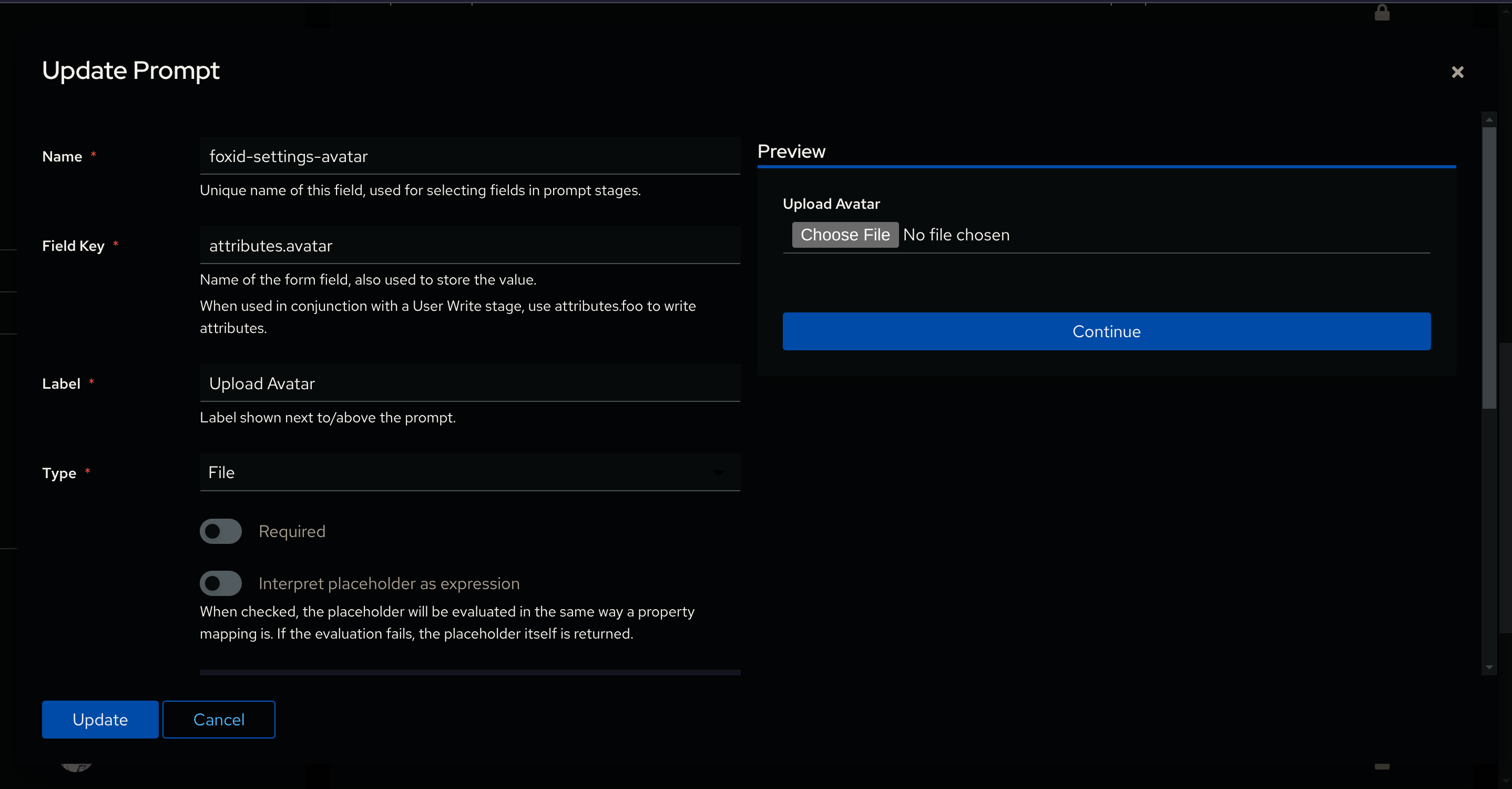
And create another one with Field Key set to attributes.avatar_reset and Type to Checkbox.
Again set Name, Label and Order to whatever makes sense for you (my Order is set to 351)
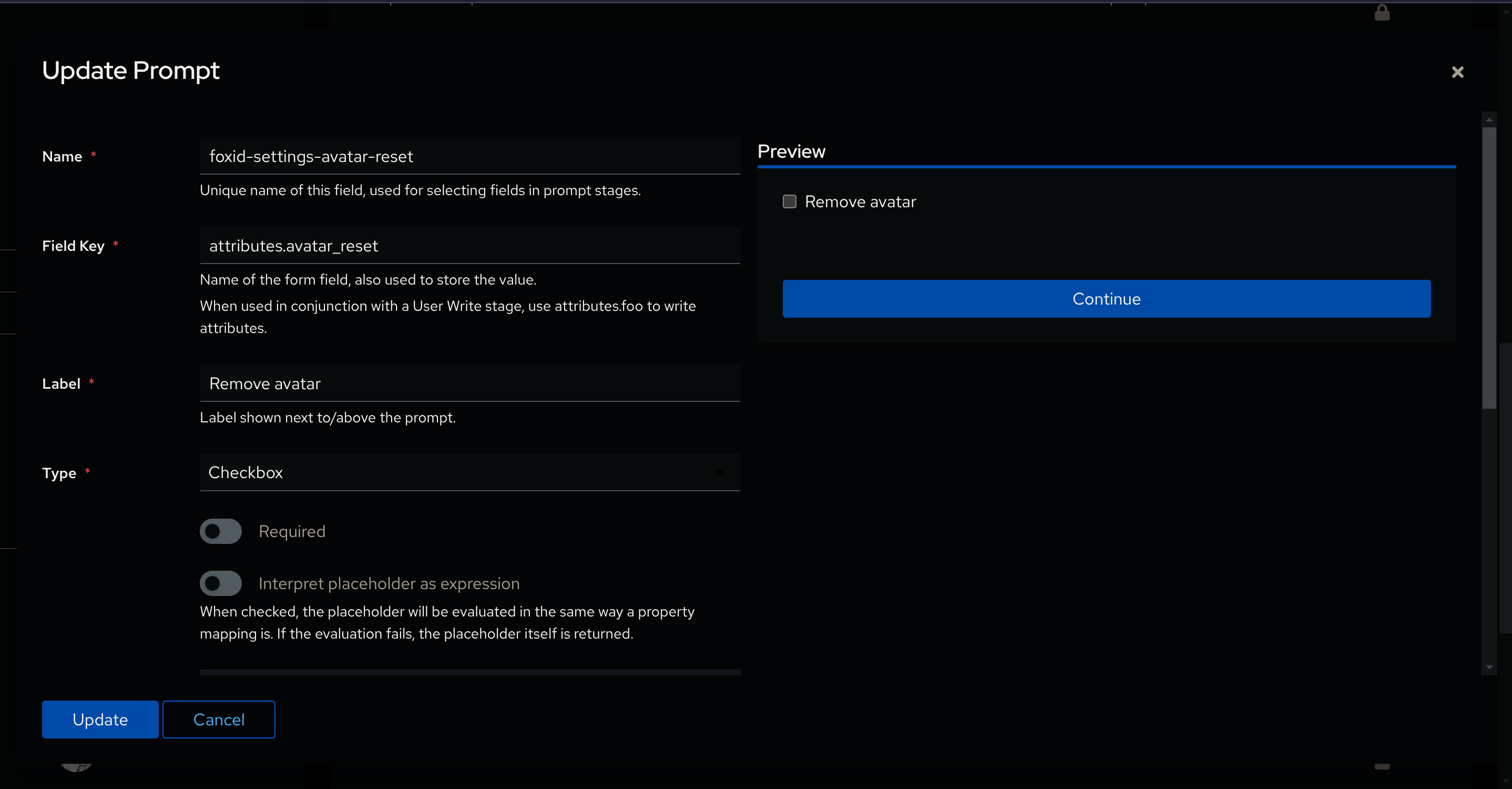
And we should have all the prompts needed!
Adding it to the settings
Go to your Settings Flow (in Flows and Stages> Flows, the default setting flow is default-user-settings-flow)
Open the flow and go to Stage Bindings and click Edit Stage on default-user-settings.
In Fields, add the Avatar Upload and Avatar Reset prompts we’ve created:
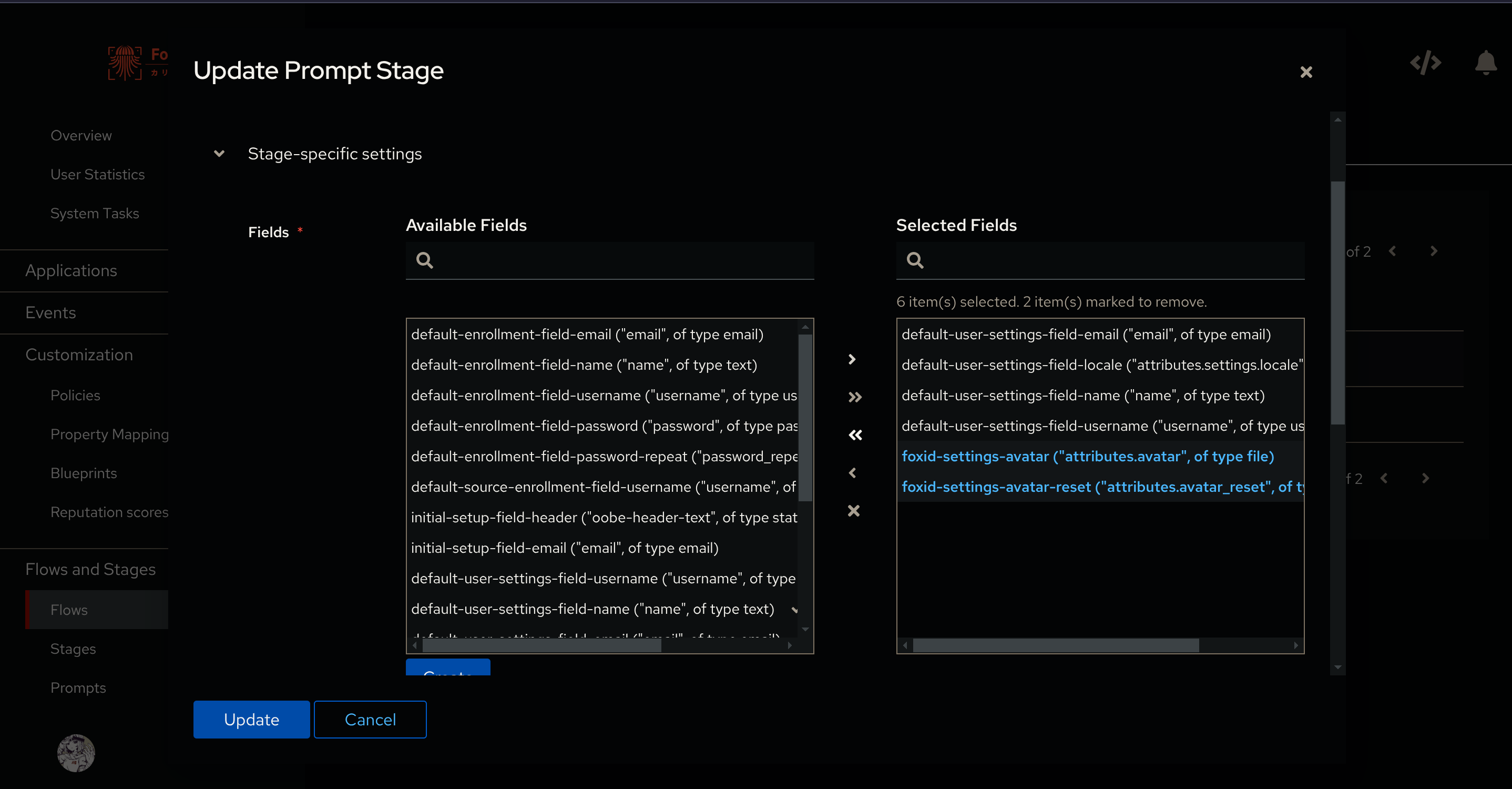
And in Validation Policies add the policy we’ve created (mine is foxid-settings-avatar):
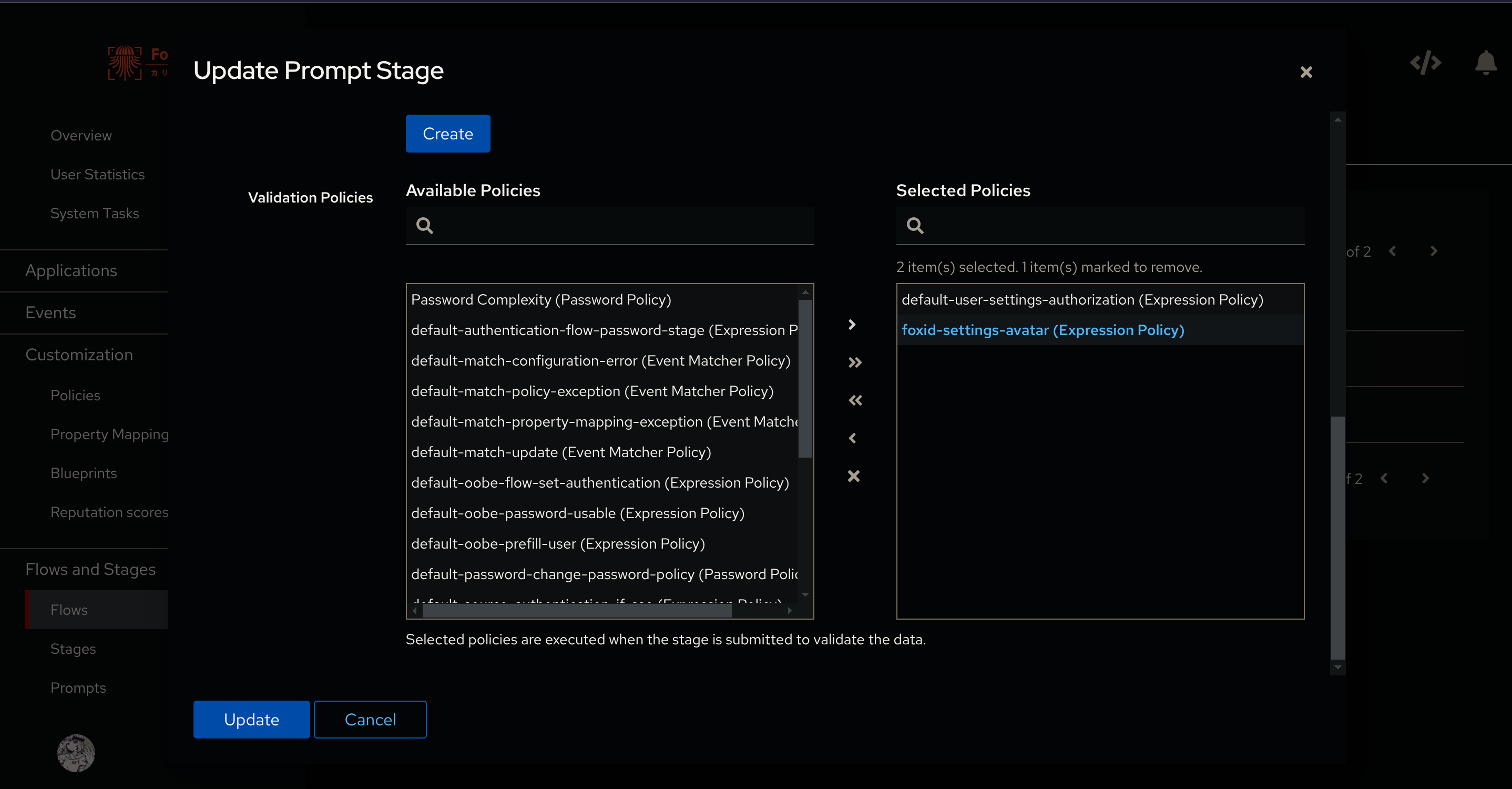
if everything was done correctly, you should now have the option to set your avatar in the settings:

Adding it in an enrollment flow
If you want to, you can allow user creating their accounts to upload a pfp by doing the same manipulation we did in the settings:
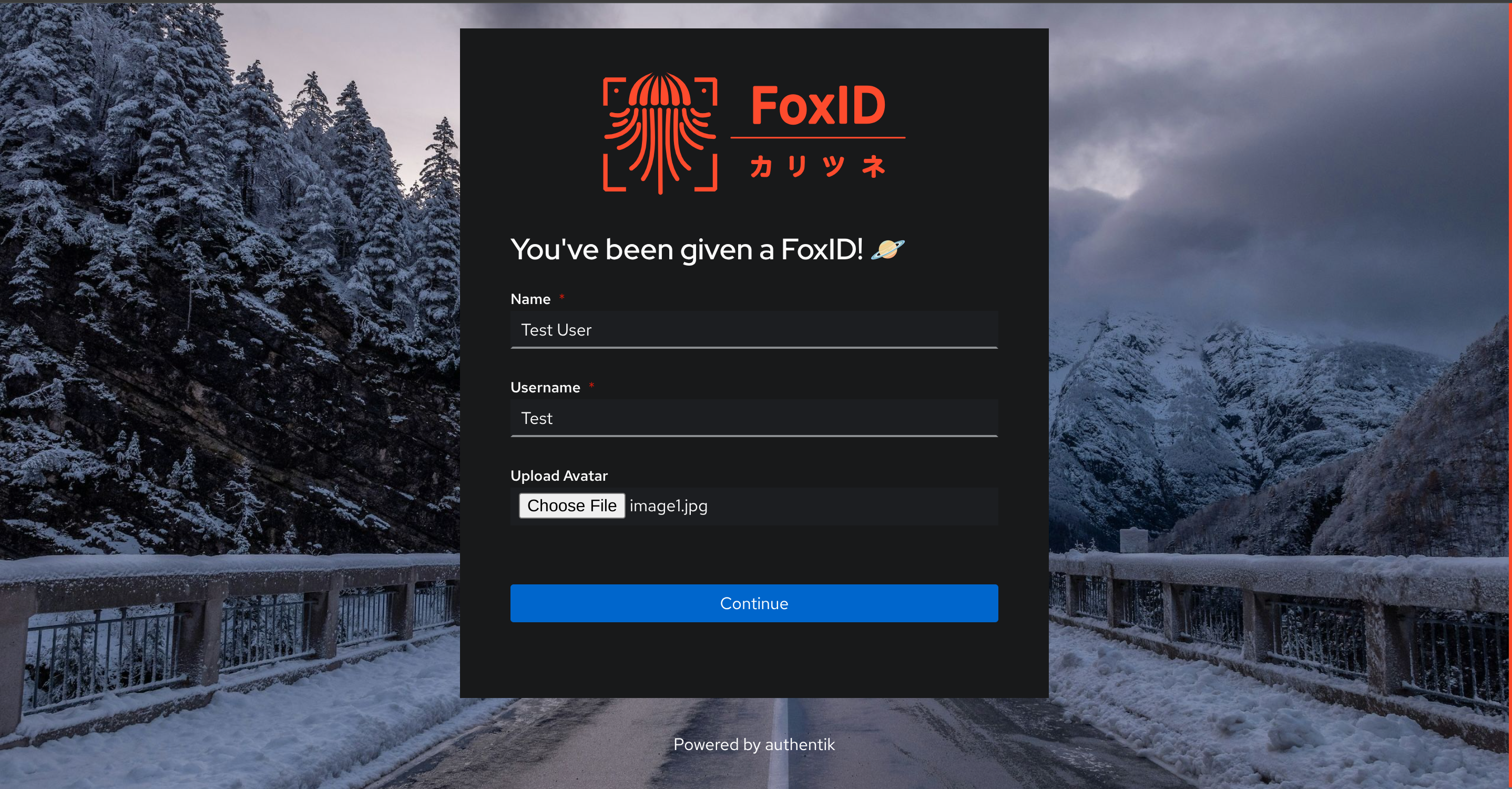 The policy is compatible with this usecase and will even sanitize and convert the uploaded files!
please bear in mind that malicious users might try to exploit this feature!
The policy is compatible with this usecase and will even sanitize and convert the uploaded files!
please bear in mind that malicious users might try to exploit this feature!
Customization: show the user profile picture in authentik
In the admin settings go to System> Settings and add attributes.avatar, at the start of the Avatar field:
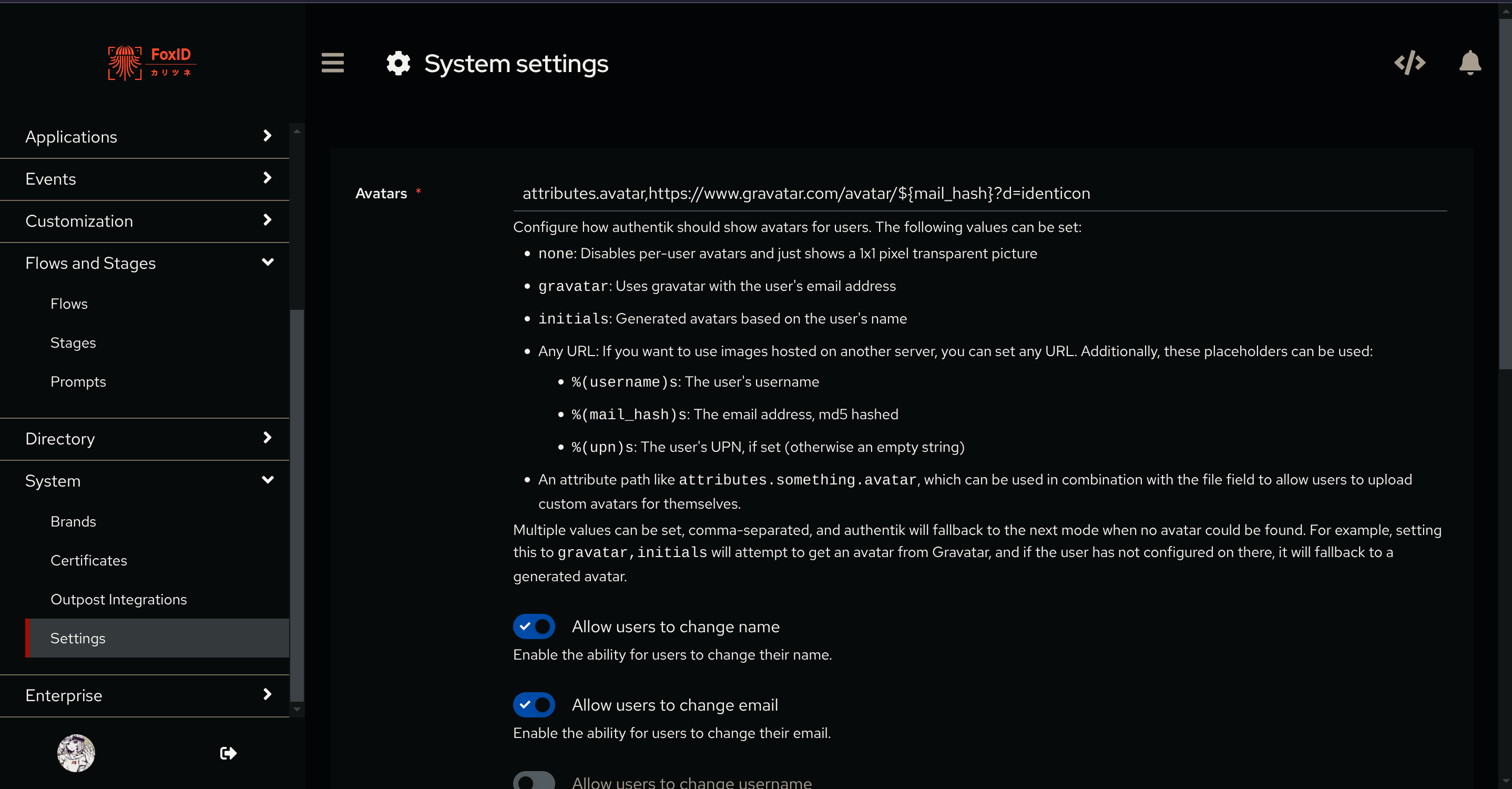 Your pfp should now appear!
Your pfp should now appear!
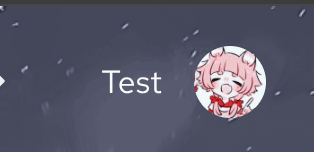
Bonus: Gravatar support and identicons
If you want, you can also enable authentik to use gravatars and identicons if the user hasn’t selected a pfp! To do so, add the following policy:
IDENTICON_URL_TEMPLATE = "https://www.gravatar.com/avatar/{mail_hash}?d=identicon"
EMPTY_FILE = "data:application/octet-stream;base64,"
import hashlib
prompt_data = request.context.get("prompt_data", {})
attributes = prompt_data.get("attributes", {})
# If avatar is missing, is the empty file, or is explicitly set to None,
# then generate an identicon.
if ("avatar" not in attributes) or (attributes.get("avatar") in [EMPTY_FILE, None, "/static/dist/assets/images/user_default.png"]):
# Retrieve the user's email; adjust if your email is stored elsewhere.
email = None
if hasattr(request.user, "email") and request.user.email:
email = request.user.email
elif "email" in attributes:
email = attributes["email"]
elif "email" in prompt_data:
email = prompt_data["email"]
if not email:
ak_message("Email not provided for identicon generation.")
return False
# Compute the MD5 hash of the normalized email.
mail_hash = hashlib.md5(email.strip().lower().encode()).hexdigest()
# Generate and assign the identicon URL.
attributes["avatar"] = IDENTICON_URL_TEMPLATE.format(mail_hash=mail_hash)
prompt_data["attributes"] = attributes
return True⚠️ This policy is intended to be ran after the first policy! I recommend using it on the User Write stage to ensure this happens:
And if everything is configured correctly you should have something like this:
![]()